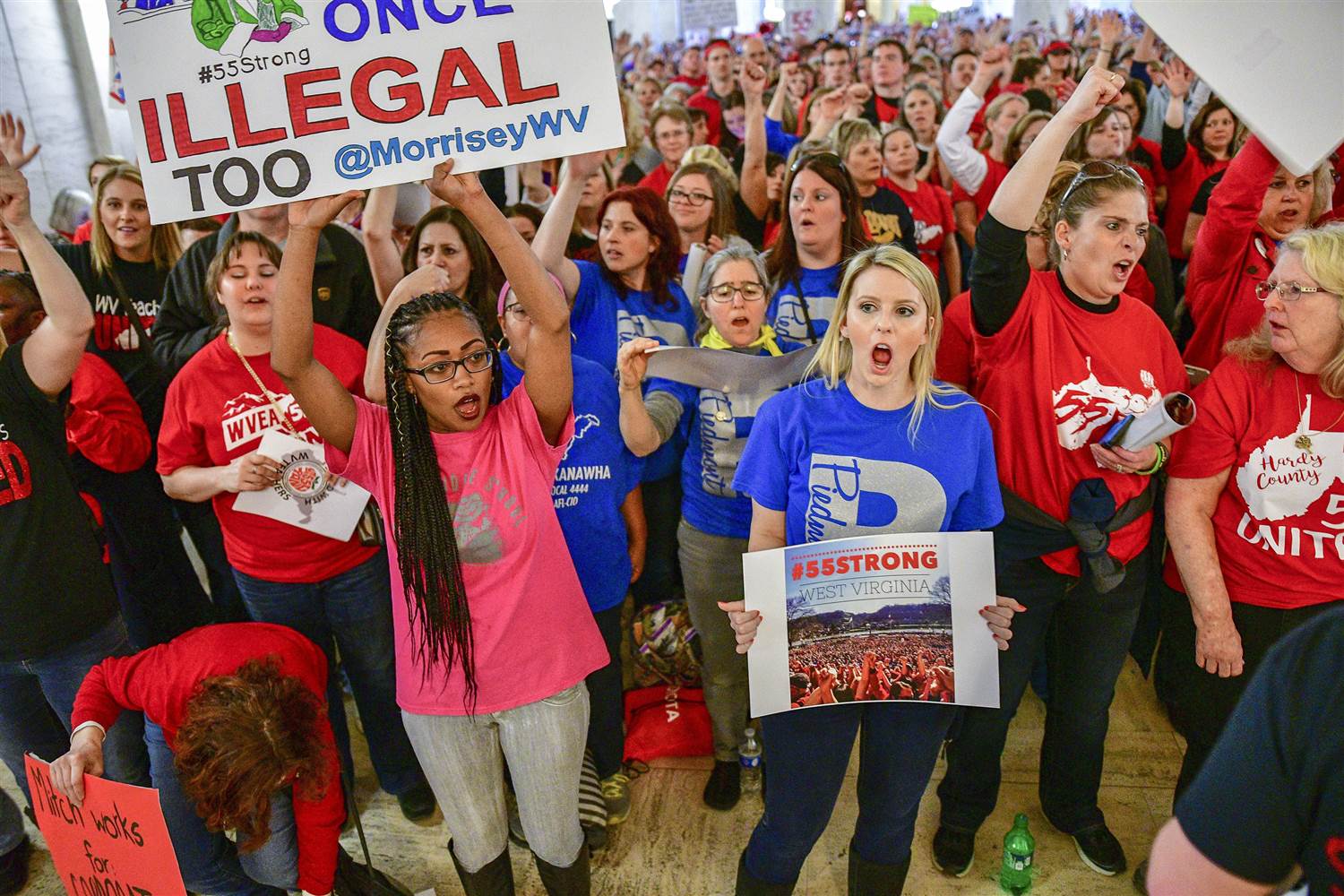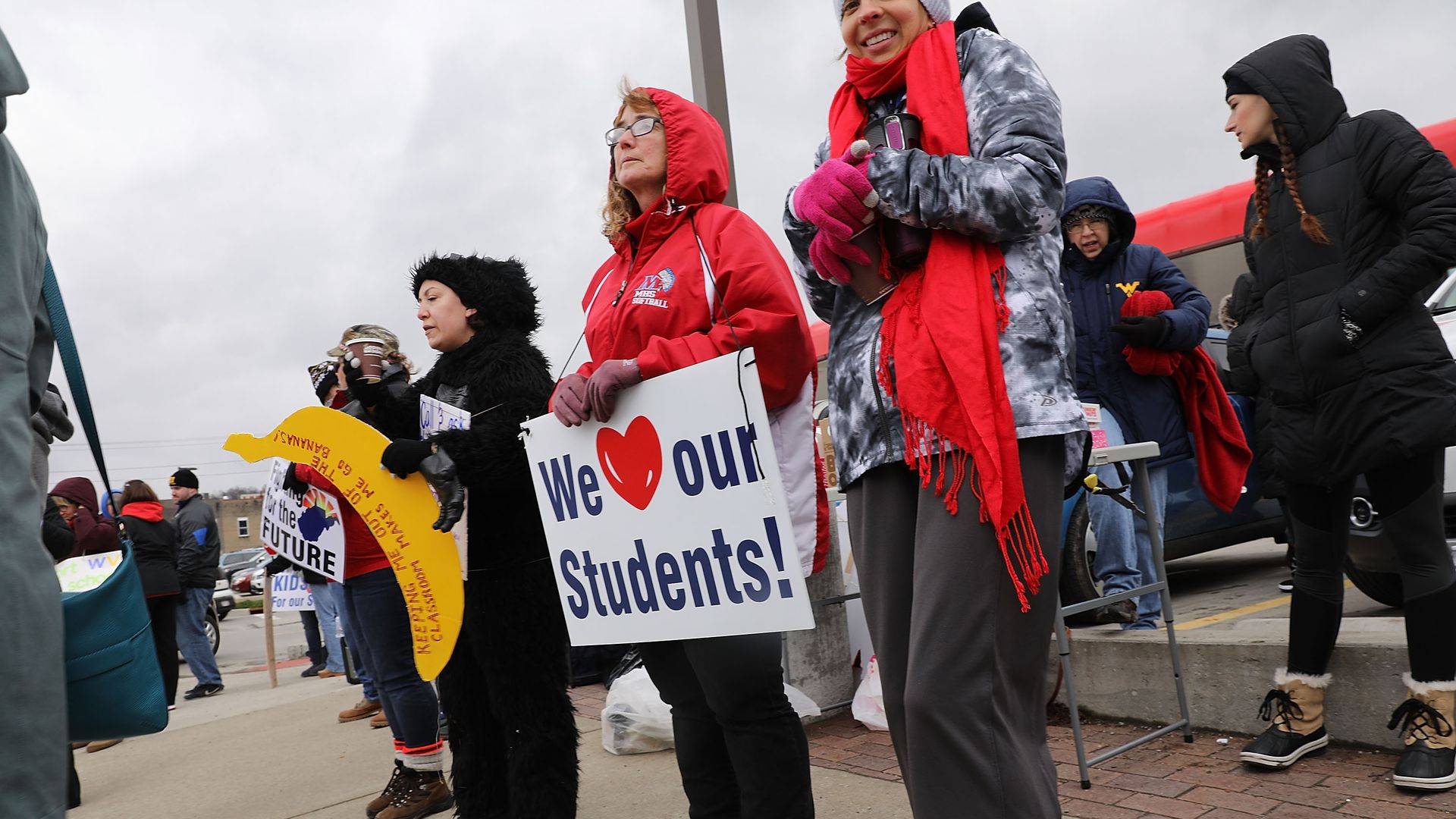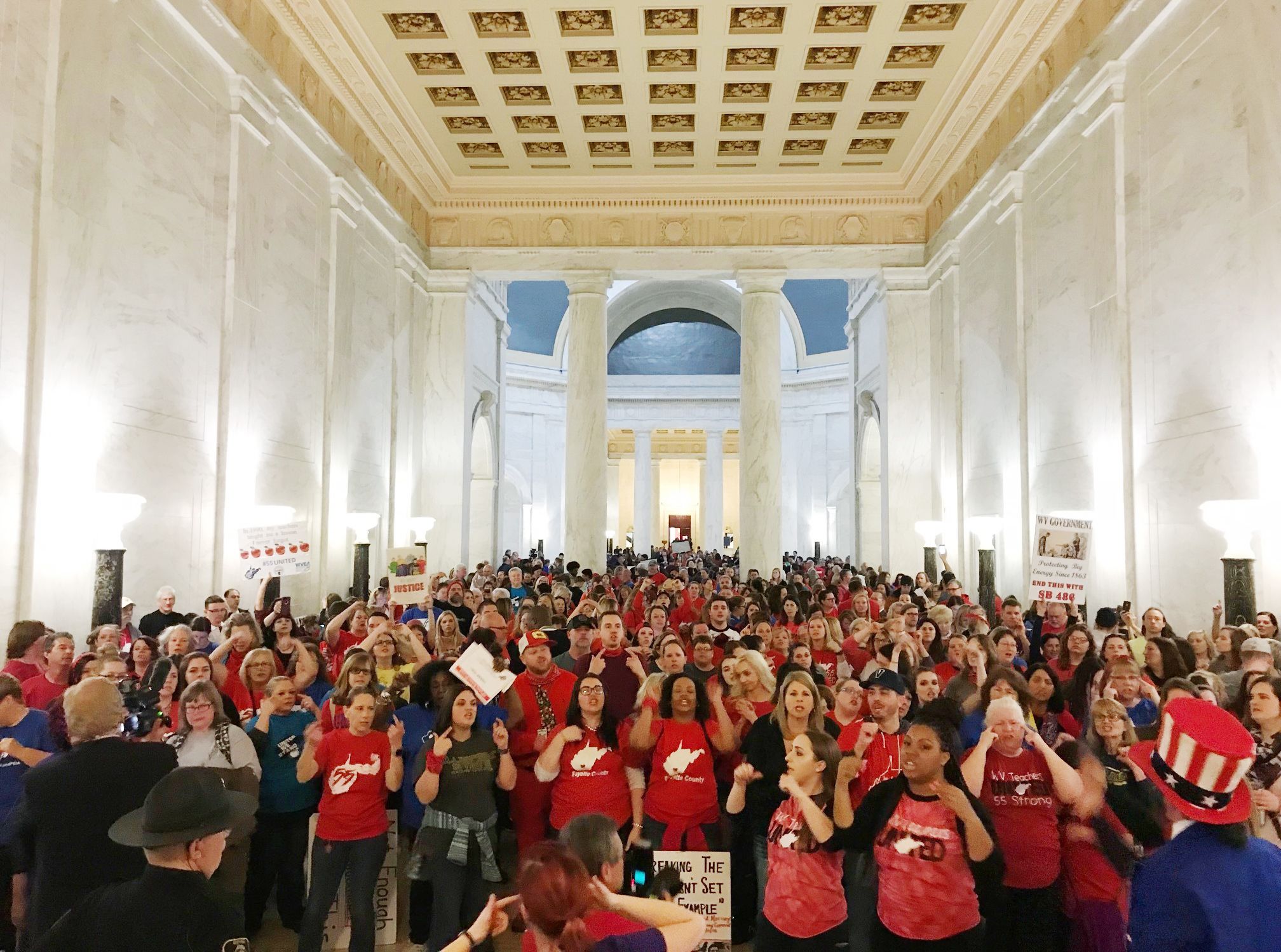
After a two-week strike and successful negotiations with the governor and state legislature, West Virginia’s teachers returned to work Wednesday with a settlement that gave them – as well as other public workers, including the state police – a 5 percent salary increase. As part of the package, Gov. Jim Justice will appoint a task force to examine the state's Public Employees Insurance Agency (PEIA) health coverage, a major concern of the teachers because of increasing premiums. The agreement was passed unanimously in both chambers of the legislature to immense relief on all sides, but serious questions remain.
The West Virginia teachers strike coincides with a potentially momentous Supreme Court case, Janus v. AFSCME, which will determine whether non-union workers under union-negotiated contracts in the public sector must pay a fee to the union for the service of negotiating their work contract. If the Janus position – supported by Koch-funded and other right-wing organizations – wins, non-union workers will no longer be required to pay those fees.
This appears likely to further undermine public sector unions, but that depends on what workers do in response. If they organize, choose their battles wisely, and act collectively, they can still win major concessions from management. We can already see this in the West Virginia action, even though the final result is unclear.
The context of the strike
It's important to note that the teachers strike comes in an environment of increased labor activism over the past several years, as well as some notable successes. Teachers in Chicago went out on strike in 2012 and won significant gains in pay and city support for schools. Nurses and other healthcare workers, including those who work in nursing homes, have organized, gone on strike and won concessions in different settings.
In addition, labor activists and their allies have worked hard to gain $15/hour minimum wages in many cities. So, while the West Virginia strike may appear like a bolt from the blue, it was not. We are in a period of mobilization for many progressive movements, including labor, that goes back at least as far as Occupy Wall Street, but has found increased energy and support during the era of Donald Trump and the right wing class warriors in Congress.
In her article “West Virginia Teachers Walk Out”, labor journalist Sarah Jaffe reviews the core issues for the teachers as well as other important concerns. For starters, West Virginia’s teachers have extremely low pay (48th in the country), while health insurance premiums have been rising and would rise significantly further were the legislation currently under consideration to go into effect. Many teachers have taken second jobs – and often three or four – to afford the insurance premiums.
At the same time, union dues collection was to be made more difficult while support for charter schools and private education funding were increased under the proposed legislation. In addition, teachers want the state to do something to fill the large number of teacher vacancies that have led to larger class sizes and teachers teaching subjects outside of their areas of qualification.
One of the most impressive aspects of the West Virginia strike is that it closed down schools in all 55 of the state’s counties. This clearly speaks to the tremendous organization and preparation by the teachers over a period of many months. That they were able to forge this unity in a rural state is even more notable. In "No Shortcuts: Organizing for Power in the New Gilded Age," activist and sociologist Jane McAlevey talks about “stress tests” for unions, in which support is built for discrete actions, which, when taken, demonstrate the union’s strength. So far, the West Virginia teachers have passed the stress test of a strike with flying colors. But if a stalemate continues, the stress will increase.
Union or no union
What is fascinating and potentially significant for other labor organizing efforts is the fact that even though many of the West Virginia teachers were not members of a union, they were able to act as if they were. In the current union environment in the U.S., many unions have been hamstrung by labor regulations and legal structures. In addition, many have made the dubious strategic choice to be a “third party” between the workers and management. In such cases, the unions often act as arbiters between labor and management instead of representing the workers or, better yet, allowing the workers to represent themselves.
In West Virginia, union staff attempted to play this role, negotiating with the governor and the legislature to get a 5 percent pay increase for educators and 3 percent for other state employees, along with the promise to study ways to fix the health insurance system. The union thought it had come away with a good deal. But the teachers said “not so fast.” In an interview in Jacobin, the teacher Jay O'Neal described what happened next:
"People were up in arms, really frustrated. Of course, a 5 percent raise is great, but what we’ve been really fighting for in this struggle is PEIA. This has been a huge issue, causing problems for years. They’ve been cutting our health insurance over and over, making it really expensive to survive.
"So when it was announced that all we got on PEIA was a task force, people were upset. Teachers in the crowd started interrupting and yelling at our leaders: “We’re not going back in for that!” Everyone started chanting, “We are the union bosses! We are the union bosses!” and “Back to the table! Back to the table!”
And, once the union went back to the table under instructions from the teachers, it was clear that it was the teachers – with all 55 counties again standing together – who were calling the shots. It will be interesting to see how the relationship between the teachers and their union changes over the next months and years, no matter the final outcome of the standoff. No doubt, other teachers and their unions will be paying attention.
How West Virginia can impact national organizing
The West Virginia strike and the organizing that went into it are an important example of what McAlevey calls “whole worker organizing.” This approach opposes the predominant assumption that workers and their issues with management must be settled in the workplace. Instead, she argues, the “whole worker” is “embedded in a range of social relationships in the workplace and in the community.”
As the title of one of the chapters in her book proclaims, “The power to win is in the community, not the boardroom.” This basic approach was followed by the teachers in Chicago in their organizing phase as they forged strong ties with parents and other members of the community who shared their interests and strongly supported the strike. The West Virginia teachers have done the same thing.
Many raised money in their communities to fund school meals for students who would be missing out on lunch because of the schools’ closing. At the same time, high school students and parents have supported the teachers and public employees. Interviewees for this article in The Nation described their “purple out” before the actual strike in support of state employees and their support for the teachers strike through their #SecureOurFuture movement.
What does the West Virginia teachers strike tell us? First, the successful organizing further supports the argument that even in these dark days for labor, workers can still “win.” McAlevey and others have argued that there are millions of workers who can be organized if unions and organizers will just end their old ways of working within the system and return to a more militant – albeit a more difficult – approach. This will be the case regardless of the Janus decision. It’s quite possible that the expected anti-union result could actually produce a backlash of organizing and greater militance.
For progressives and Democrats thinking about what to do if they can seize power in Washington in 2018 and 2020, the urgency and the potential for major pro-labor legislation should be even more apparent. They should be considering activist Shaun Richman’s Labor Bill of Rights.
Finally, thinking strategically about progressive political action, the idea of “whole worker organizing” situating workers in their communities also provides a channel for progressive activists to enlist workers and communities in electoral politics. The full story of the West Virginia teachers strike will not be told for some time. But as the accounts of how it happened come to light, it will be important to chart the more overtly political inputs to the teachers movement and the political movements that may arise from it.
Measuring the results – and the costs
As stated earlier, the West Virginia settlement satisfies important teacher demands. But it may potentially contain some bitter pills as well.
Although the settlement gives teachers and other state employees the 5 percent salary increase they demanded, it is unclear how those increases will be paid for – a separate question confronting the legislature in the coming months. So far, there seems to be little inclination to tax the coal and gas industries as the teachers proposed. Instead there have been proposals to pay for the raise through cuts to social service programs, Medicaid and community college tuition assistance grants.
Such a trade-off would be damaging in two ways. First, it would take away funding for crucial programs that help a large number of West Virginians. Second, it would split the teachers from the rest of the people in the state, giving the Republicans in the legislature a powerful weapon in their ongoing campaign to cut social programs while supporting the corporate extractive industries. That weapon is the ability to call the teachers and their allies “special interests” who demand extra goodies from the state that most residents cannot get. It’s an old strategy pursued successfully by Republicans in many states.
The dilemma for the West Virginia teachers is exactly that faced by progressive forces nationwide. While there is very strong support for social programs and workers' rights, corporate-funded politicians in government are often able to withstand public opinion thanks to their ability to skew the political process through gerrymandering and voter suppression, as well as their skill raising piles of cash that help keep them in office.
For now, the irresistible force of the teachers movement will continue to face implicit opposition from the immovable object of the Republican-dominated state legislature. But if progressive forces remain active and keep organizing, they will have an opportunity to take the battle directly into the political arena in 2018 and 2020. Democratic lawmakers are already anticipating a fight.
Delegate Isaac Sponaugle urged the teachers to remain engaged because the current legislature was unlikely to fix the health insurance plan, while the opposition would seek to reverse their gains. “If you do not come back this November, they’re going to come back with vengeance,” he said.
Impressive gains have been achieved, but the struggle isn't over by any stretch of the imagination. What happens in the coming months will be just as important as the events of the past two weeks.
3 WAYS TO SHOW YOUR SUPPORT
- Log in to post comments
















